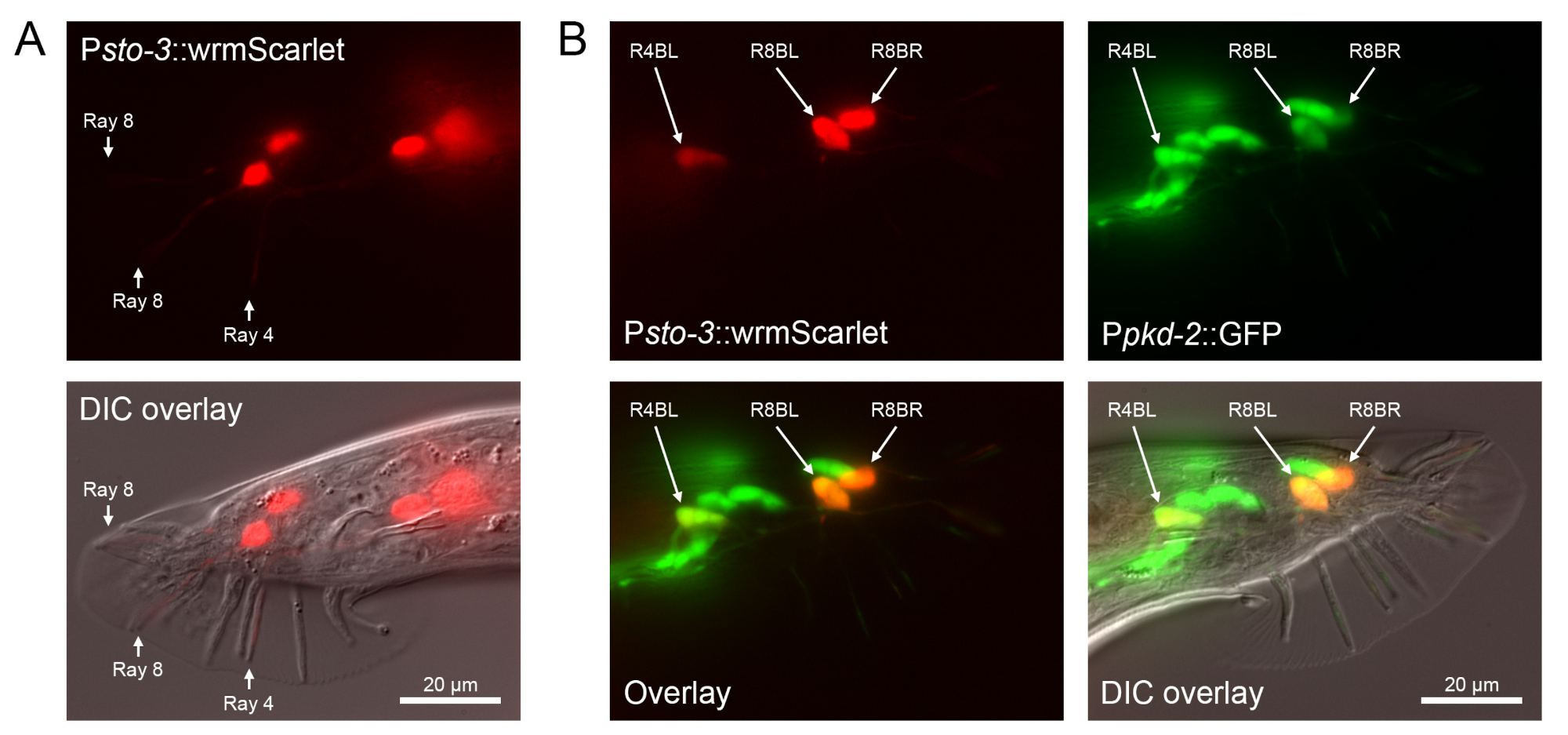University of Massachusetts Medical School, Neurobiology Department, Worcester, MA, USA
Laboratory of the Physics of Biological Systems, Institute of Physics, École Polytechnique Fédérale de Lausanne (EPFL), CH-1015 Lausanne, Switzerland
Description
In C. elegans hermaphrodites, sto-3 promoter has been previously shown to drive gene expression in RIBL/R neurons and in three unidentified non-neuronal cells in the tail (Turek et al., 2016). (A) We have found that in C. elegans males, in addition to RIBL/R, two pairs of bilaterally-symmetrical tail neurons show strong Psto3::wrmScarlet expression (wrmScarlet is a codon-optimized version of mScarlet (El Mouridi et al., 2017)). These neurons send their processes to rays 4 and 8 of the male tail. In the figure, right lateral aspect is shown; arrows indicate rays containing processes expressing Psto3::wrmScarlet. (B) All rays in the male tail are innervated by A and B type neurons (Sulston et al., 1980). To identify which neuron type expresses the sto-3 reporter, we have crossed Psto3::wrmScarlet transgenic males with a Ppkd-2::GFP reporter strain MT11318, which expresses GFP in the B-type neurons of rays 1-5, 7-9 and not in the A-type neurons (Barr and Sternberg, 1999). In the F1 cross-progeny males, which also carried the ceh-30(n3714) mutation in the background, Psto-3::wrmScarlet expression is colocalized with Ppkd-2::GFP for both pairs of ray neurons expressing Psto-3::wrmScarlet. This indicates that sto-3 is expressed in the R4BL/R and R8BL/R ray neurons. Left lateral aspect; arrows point at the cell bodies of Psto3::wrmScarlet-expressing neurons.
Reagents
zfEx898[Psto-3::wrmScarlet + lin-15(+)]; lin-15 (n765ts) X. Psto-3::wrmScarlet transcriptional fusion. The plasmid was made by cloning 971 bp promoter region of sto-3 into a wrmScarlet-unc-54 3’UTR vector with a pUC19 vector backbone.
Strains: QW1876.
Acknowledgments
We thank Steven Flavell for sharing a plasmid from which sto-3 promoter was cloned, and we thank Mei Zhen for providing a wrmScarlet-unc-54 3’UTR construct.
References
Funding
This work was supported by NIH 5R01NS082525-04 and École Polytechnique Fédérale de Lausanne (EPFL).
Reviewed By
AnonymousHistory
Received: March 4, 2019Accepted: March 6, 2019
Published: March 6, 2019
Copyright
© 2019 by the authors. This is an open-access article distributed under the terms of the Creative Commons Attribution 4.0 International (CC BY 4.0) License, which permits unrestricted use, distribution, and reproduction in any medium, provided the original author and source are credited.Citation
Susoy, V; Joyce, WJ; Rahi, SJ (2019). sto-3 is expressed in R4BL/R and R8BL/R, male-specific ray neurons in C. elegans. microPublication Biology. 10.17912/micropub.biology.000091.Download: RIS BibTeX




